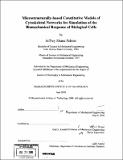| dc.contributor.advisor | Mary C. Boyce. | en_US |
| dc.contributor.author | Palmer, Jeffrey Shane | en_US |
| dc.contributor.other | Massachusetts Institute of Technology. Dept. of Mechanical Engineering. | en_US |
| dc.date.accessioned | 2009-03-16T19:38:35Z | |
| dc.date.available | 2009-03-16T19:38:35Z | |
| dc.date.copyright | 2008 | en_US |
| dc.date.issued | 2008 | en_US |
| dc.identifier.uri | http://hdl.handle.net/1721.1/44752 | |
| dc.description | Thesis (Ph. D.)--Massachusetts Institute of Technology, Dept. of Mechanical Engineering, 2008. | en_US |
| dc.description | Includes bibliographical references (v. 2, p. 335-375). | en_US |
| dc.description.abstract | The elastic and viscoelastic stress-strain behavior of cytoskeletal networks, important to many cellular functions, is modeled via a microstructurally-informed continuum mechanics approach. The force-extension behavior of the individual filaments is captured with a new analytical expression of the MacKintosh worm-like chain relationship for semiflexible filaments. The filament expression is used in the Arruda-Boyce eight-chain network model to capture the 3D stress-strain behavior, quantifying the effects of isotropic network prestress and tracking microstructural stretch and orientation states during large deformations. The network model captures the initial stiffness of the network as well as the nonlinear strain stiffening observed at large stresses in shear rheological data of bundled/unbundled in vitro F-actin networks. The cytoskeletal network model has also been extended to include the internal energy based mechanical contributions at the filament and network levels from torsional crosslink deformations as well as from direct axial stretching of filaments. This enhanced model effectively captures the stress-strain behavior of F-actin networks cross-linked with two different types of actin binding proteins (filamin and streptavidin). The enhanced model is also used to evaluate the influence of the cross-links' torsional stiffness on the entropic bending configuration space of the cytoskeletal filaments. The 3D constitutive network model provides a framework for capturing time-dependent spatial diffusion of cytosol within a porous, visco hyperelastic filament network. The poroelastic behavior is coupled with the hyperelastic network behavior through a 3D biphasic theory that includes network swelling effects for finite deformations. | en_US |
| dc.description.abstract | (cont.) The mechanical response of the cytoskeletal network due to the localized swelling is captured by employing multiplicative decomposition of mechanical and swelling stretches. Nonlinear shear viscoelasticity is also included to create a 3D network model capable of capturing the time-dependent response of cytoskeletal networks on short and long time scales. The model captures the nonlinear time dependent behavior of in vitro actin-filamin and actin-avidin networks observed in shear rheological experiments. The constitutive models are evaluated in a finite element model with a cellular geometry (including membrane and nucleus submodels) and the ability to spatially vary network properties throughout the cell. | en_US |
| dc.description.statementofresponsibility | by Jeffrey Shane Palmer. | en_US |
| dc.format.extent | 2 v. (375 leaves) | en_US |
| dc.language.iso | eng | en_US |
| dc.publisher | Massachusetts Institute of Technology | en_US |
| dc.rights | M.I.T. theses are protected by
copyright. They may be viewed from this source for any purpose, but
reproduction or distribution in any format is prohibited without written
permission. See provided URL for inquiries about permission. | en_US |
| dc.rights.uri | http://dspace.mit.edu/handle/1721.1/7582 | en_US |
| dc.subject | Mechanical Engineering. | en_US |
| dc.title | Microstructurally-based constitutive models of cytoskeletal networks for simulation of the biomechanical response of biological cells | en_US |
| dc.type | Thesis | en_US |
| dc.description.degree | Ph.D. | en_US |
| dc.contributor.department | Massachusetts Institute of Technology. Department of Mechanical Engineering | |
| dc.identifier.oclc | 298563562 | en_US |
